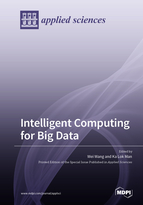Intelligent Computing for Big Data
A special issue of Applied Sciences (ISSN 2076-3417). This special issue belongs to the section "Computing and Artificial Intelligence".
Deadline for manuscript submissions: closed (31 August 2022) | Viewed by 19316
Special Issue Editors
Interests: data and knowledge engineering
Special Issues, Collections and Topics in MDPI journals
Interests: AI; IoT; big data analytics; IC designs; WSN
Special Issues, Collections and Topics in MDPI journals
Special Issue Information
Dear Colleagues,
Research on big data processing and analytics has achieved considerable success in the past decades. Nevertheless, the promise of allowing the extraction of valuable information and trustworthy knowledge from a tremendous amount of data of various forms and modalities has yet come true. Recent advances in artificial intelligence research have the potential to move the current big data research one step further. A number of AI techniques, especially deep learning, has achieved breakthroughs in many applications relating to natural language processing, image and video data processing, and multi-modal data fusion. However, there are still many challenges in intelligent computing with big data, most of which arise due to the nature of big data, for example, noise (social media data), various modalities (Internet of Things data), and unlabelled or limited amounts of labelled data.
This Special Issue will consist of selected excellent papers from the 2021 4th International Conference on Computing and Big Data (ICCBD 2021), which will be held in China, on 27-29 November 2021. Contributors will be invited to submit and present papers in a wide variety of areas from concepts to applications. Related submissions outside the conference are also very welcome.
The goal of this Special Issue is to solicit high-quality, original research papers on the following topics, but not limited to them:
- Intelligent computing from Internet of Things data;
- Intelligent computing from social media data;
- Intelligent computing for unlabelled big data;
- Deep learning in big data applications;
- Knowledge graph in big data systems;
- Search, retrieval, recommendation and summarisation in large knowledge graphs and linked data;
- Big data applications in government, healthcare, bioinformatics, and business;
- Privacy preserving in big data analytics;
- Evaluation methods for big data analytics;
- Security, trust and privacy in big data;
- Big Data modelling, storage, indexing, searching and querying;
- Cloud technologies for big data and intelligent computing;
- Blockchain technologies for big data and intelligent computing.
Prof. Dr. Wei Wang
Dr. Ka Lok Man
Guest Editors
Manuscript Submission Information
Manuscripts should be submitted online at www.mdpi.com by registering and logging in to this website. Once you are registered, click here to go to the submission form. Manuscripts can be submitted until the deadline. All submissions that pass pre-check are peer-reviewed. Accepted papers will be published continuously in the journal (as soon as accepted) and will be listed together on the special issue website. Research articles, review articles as well as short communications are invited. For planned papers, a title and short abstract (about 100 words) can be sent to the Editorial Office for announcement on this website.
Submitted manuscripts should not have been published previously, nor be under consideration for publication elsewhere (except conference proceedings papers). All manuscripts are thoroughly refereed through a single-blind peer-review process. A guide for authors and other relevant information for submission of manuscripts is available on the Instructions for Authors page. Applied Sciences is an international peer-reviewed open access semimonthly journal published by MDPI.
Please visit the Instructions for Authors page before submitting a manuscript. The Article Processing Charge (APC) for publication in this open access journal is 2400 CHF (Swiss Francs). Submitted papers should be well formatted and use good English. Authors may use MDPI's English editing service prior to publication or during author revisions.







